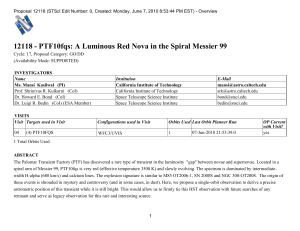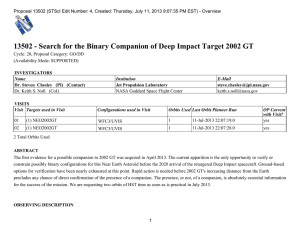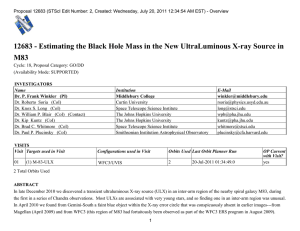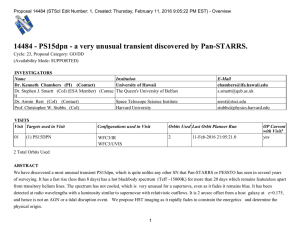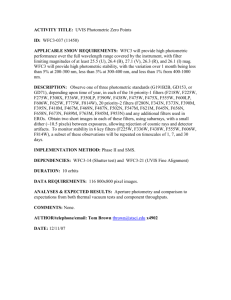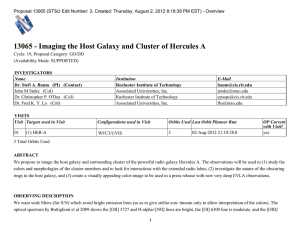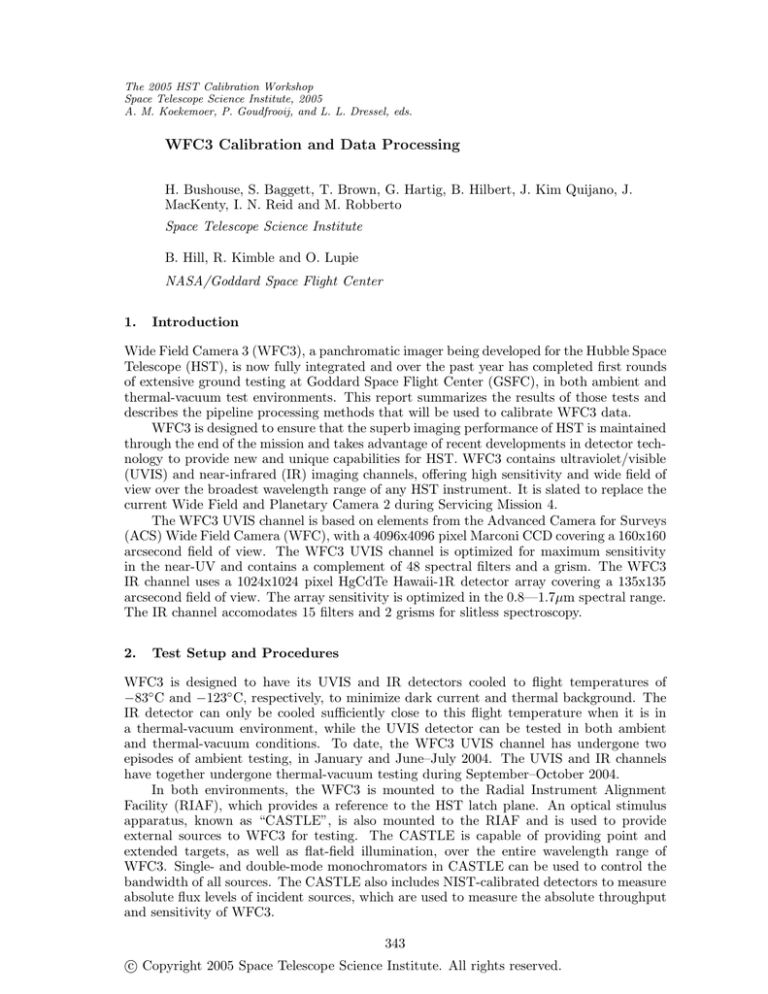
The 2005 HST Calibration Workshop
Space Telescope Science Institute, 2005
A. M. Koekemoer, P. Goudfrooij, and L. L. Dressel, eds.
WFC3 Calibration and Data Processing
H. Bushouse, S. Baggett, T. Brown, G. Hartig, B. Hilbert, J. Kim Quijano, J.
MacKenty, I. N. Reid and M. Robberto
Space Telescope Science Institute
B. Hill, R. Kimble and O. Lupie
NASA/Goddard Space Flight Center
1.
Introduction
Wide Field Camera 3 (WFC3), a panchromatic imager being developed for the Hubble Space
Telescope (HST), is now fully integrated and over the past year has completed first rounds
of extensive ground testing at Goddard Space Flight Center (GSFC), in both ambient and
thermal-vacuum test environments. This report summarizes the results of those tests and
describes the pipeline processing methods that will be used to calibrate WFC3 data.
WFC3 is designed to ensure that the superb imaging performance of HST is maintained
through the end of the mission and takes advantage of recent developments in detector technology to provide new and unique capabilities for HST. WFC3 contains ultraviolet/visible
(UVIS) and near-infrared (IR) imaging channels, offering high sensitivity and wide field of
view over the broadest wavelength range of any HST instrument. It is slated to replace the
current Wide Field and Planetary Camera 2 during Servicing Mission 4.
The WFC3 UVIS channel is based on elements from the Advanced Camera for Surveys
(ACS) Wide Field Camera (WFC), with a 4096x4096 pixel Marconi CCD covering a 160x160
arcsecond field of view. The WFC3 UVIS channel is optimized for maximum sensitivity
in the near-UV and contains a complement of 48 spectral filters and a grism. The WFC3
IR channel uses a 1024x1024 pixel HgCdTe Hawaii-1R detector array covering a 135x135
arcsecond field of view. The array sensitivity is optimized in the 0.8—1.7µm spectral range.
The IR channel accomodates 15 filters and 2 grisms for slitless spectroscopy.
2.
Test Setup and Procedures
WFC3 is designed to have its UVIS and IR detectors cooled to flight temperatures of
−83◦ C and −123◦ C, respectively, to minimize dark current and thermal background. The
IR detector can only be cooled sufficiently close to this flight temperature when it is in
a thermal-vacuum environment, while the UVIS detector can be tested in both ambient
and thermal-vacuum conditions. To date, the WFC3 UVIS channel has undergone two
episodes of ambient testing, in January and June–July 2004. The UVIS and IR channels
have together undergone thermal-vacuum testing during September–October 2004.
In both environments, the WFC3 is mounted to the Radial Instrument Alignment
Facility (RIAF), which provides a reference to the HST latch plane. An optical stimulus
apparatus, known as “CASTLE”, is also mounted to the RIAF and is used to provide
external sources to WFC3 for testing. The CASTLE is capable of providing point and
extended targets, as well as flat-field illumination, over the entire wavelength range of
WFC3. Single- and double-mode monochromators in CASTLE can be used to control the
bandwidth of all sources. The CASTLE also includes NIST-calibrated detectors to measure
absolute flux levels of incident sources, which are used to measure the absolute throughput
and sensitivity of WFC3.
343
c Copyright 2005 Space Telescope Science Institute. All rights reserved.
344
Bushouse et al.
During routine data taking episodes, WFC3 test exposures are commanded via an
HST-style SMS that is run on the instrument. Complementary scripts are used to control
the CASTLE optical stimulus, to provide the desired source for each exposure, resulting in
a highly automated process. All exposures are processed, previewed, and archived locally,
and are also automatically sent to the STScI pipeline (OPUS) system to be converted to
FITS files and stored in the long-term HST archive.
3.
Ground Tests Performed
The goals of the ground tests performed to date were to:
• characterize the thermal performance of WFC3
• demonstrate flight-like operations of the UVIS and IR channels
• verify and characterize the science capabilities of WFC3
The types of tests that have been performed during the ambient and thermal-vacuum
testing campaigns include detector alignment, encircled energy, read noise, dark current,
flat field uniformity, detector gain, detector linearity, detector crosstalk, image stability,
grism dispersion, filter ghosts, system and filter throughputs, internal calibration system
flux level and uniformity, and IR thermal background measurements.
4.
Testing Results
The high-level results of these tests include: 1) the first integrated operation of the IR
channel; 2) the same good performance of the UVIS and IR detectors seen in previous
unit tests before integration into the instrument; 3) the demonstration of routine science
operations in flight-like conditions; 4) good margins on the achievable UVIS and IR detector
temperatures; 5) lower than expected IR thermal background, based on previous subsystem
tests; and 6) excellent optical performance, with UVIS and IR image quality at or near
specifications at all wavelengths.
All data analysis results to date have been documented in a series of over thirty Instrument Science Reports (ISRs), which are available for viewing and downloading from the
HST WFC3 web site at http://www.stsci.edu/hst/wfc3/documents/ISRs.
4.1.
Detector Characteristics
The results of specific tests of detector characteristics are shown in Table 1 and Table 2
for the UVIS and IR channels, respectively. Included in these tables is the Contract End
Item (CEI) specification for each characteristic. As can be seen from the tables, the only
detector characteristic that does not currently meet the specifications is the IR read noise
(note that the values quoted are for a subtracted pair of non-destructive readouts).
Table 1: UVIS Detector Characteristics
Item
Dark current
Read noise
Linearity
Full well
Measured Value
0.3 e− /pix/hour
3.0 e− /pix
5% deviation at 67,000 e− /pix
∼70,000 e− /pix
CEI Specification
<20 e− /pix/hour
<4 e− /pix
<5% up to 50,000 e− /pix
>50,000 e− /pix
WFC3 Calibration and Data Processing
345
Table 2: IR Detector Characteristics
Item
Dark current
Read noise
Linearity
Full well
4.2.
Measured Value
0.15 e− /pix/sec
∼22 e− /pix rms
5% deviation at 93,000 e− /pix
∼105,000 e− /pix
CEI Specification
<0.4 e− /pix/sec
15 e− /pix rms
<5% up to 70,000 e− /pix
>100,000 e− /pix
Optical Characteristics
The results of encircled energy measurements are shown in Table 3.
Table 3: Encircled Energy
Channel
UVIS
IR
Wavelength
250 nm
633 nm
1.0 µm
IR
1.6 µm
72%
79%
60%
75%
46%
80%
in
in
in
in
in
in
0.20
0.25
0.25
0.37
0.25
0.60
Encircled Energy
arcsecond radius
arcsecond radius
arcsecond radius
arcsecond radius
arcsecond radius
arcsecond radius
The blue-optimized CCD’s of the WFC3 UVIS channel result in system throughputs
that are below that of ACS/WFC at the red end of the optical range, yet far exceed that
of WFPC-2 at near-UV wavelengths. Figure 1 shows the througput of the UVIS channel
(optics+detector) without filters in place.
WFC3 IR channel throughputs are 50% or more higher than that of the HST NICMOS
cameras over the 0.9—1.7µm wavelength range. Figure 2 shows the throughput of the entire
IR channel as seen through each IR filter.
5.
Pipeline Processing
The calwf3 pipeline that will be used in the STScI OPUS system to calibrate WFC3 data
will be very similar to the calacs pipeline in high-level structure (see Hack 1999a). There
will be two main branches: one for UVIS channel images and another for IR images. The
steps applied on the UVIS branch will be the same as what’s used for ACS/WFC images
and the IR steps will be similar to NICMOS processing (Hack 1999b; Bushouse, Skinner &
MacKenty 1997). Figure 3 shows the high-level data flow through calwf3 processing.
Basic calibration will include the usual necessary steps such as bias and dark subtraction, flat fielding, and saturation and bad pixel flagging. UVIS images will also have shutter
shading and post-flash corrections, as necessary. IR exposures will receive a non-linearity
correction and “up the ramp” fitting, which includes CR rejection. Scientific operations of
the instrument will allow for subarray readouts in both the UVIS and IR channels, as well
as on-chip binning, by factors of 2 and 3, in the UVIS channel. The calibration pipeline will
accomodate all of these modes, using subarray extractions of reference images and binned
reference images. A major new feature of the WFC3 IR channel detector is the inclusion
of a set of “reference” pixels around the perimeter of the the detector array, which are
not sensitive to light but are otherwise included in the remaining electronic readout chain.
346
Bushouse et al.
UVIS CLEAR throughput
Throughput (absolute w/q-yield cor.)
0.5
0.4
0.3
0.2
0.1
CHIP 1
CHIP 2
0.0
200
400
600
Wavelength (nm)
800
1000
Figure 1: UVIS channel clear throughput
IR filtered throughput
0.6
0.4
0.3
0.2
1000
1200
1400
Wavelength (nm)
Figure 2: IR channel filtered throughput
1600
F167N
F164N
F160W
F153M
F139M
F130N
F132N
F125W
F126N
F127M
F128N
F110W
F105W
0.0
F098M
0.1
F093W
Throughput (absolute)
0.5
WFC3 Calibration and Data Processing
Detector
347
CCD
IR
Another Image in
CR-SPLIT or
RPT-OBS set?
WF3CCD
Another
Image in
RPT-OBS set?
DQI, Blev, Bias, Flash
WF3IR
Zoff, DQI, Dark, Blev,
Nlin, Flat, Phot, Crrej, Stat
Yes
CRCORR
RPTCORR
WF3REJ
CR Rejection
WF3CCD
Yes
Dark, Flat, Shad
Phot, Stat
RPTCORR
WF3REJ
Another Set of CR-SPLIT
or RPT-OBS Images?
CR Rejection
Another Set of
RPT-OBS Images?
Yes
DRZCORR
WF3DRZ
Image Drizzling
Figure 3: CALWF3 high-level flow
These pixels will be used by the IR branch of calwf3 to track and remove drifts in the
detector bias level from readout to readout within a given exposure.
The ground system will allow observers to obtain multiple exposures on a target, in
either CR-SPLIT or REPEAT-OBS modes. These multiple images will be associated and
combined during calwf3 processing. Both UVIS and IR calibrated images will receive drizzle processing, either as individual images or as associated sets (e.g. for dithered patterns).
Drizzle processing is necessary, even for individual images, in order to remove geometric
distortions and to correct for distortion-induced photometric errors.
References
Bushouse, H., Skinner, C., & MacKenty, J. 1997, Instrument Science Report NICMOS
97-28, (Baltimore: STScI)
Hack, W. 1999a, Instrument Science Report ACS 99-03, (Baltimore: STScI)
Hack, W. 1999b, Instrument Science Report ACS 99-08, (Baltimore: STScI)

